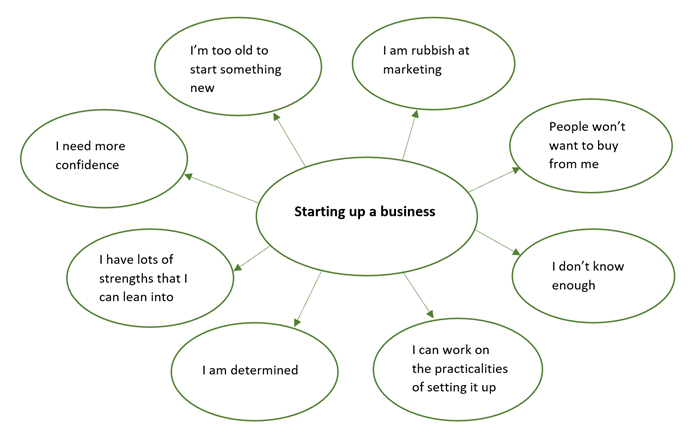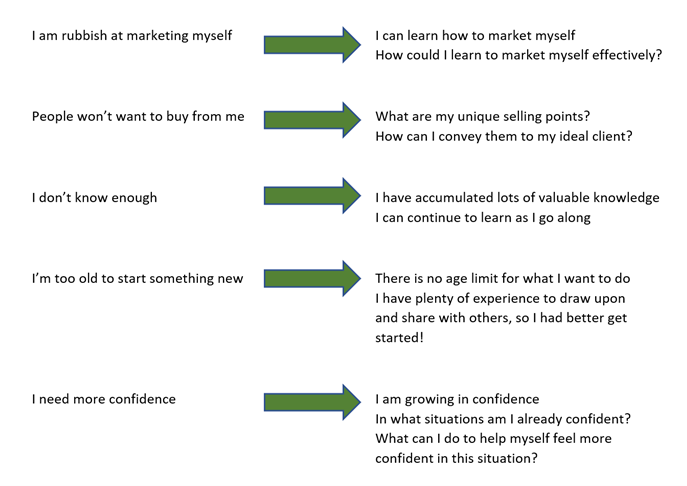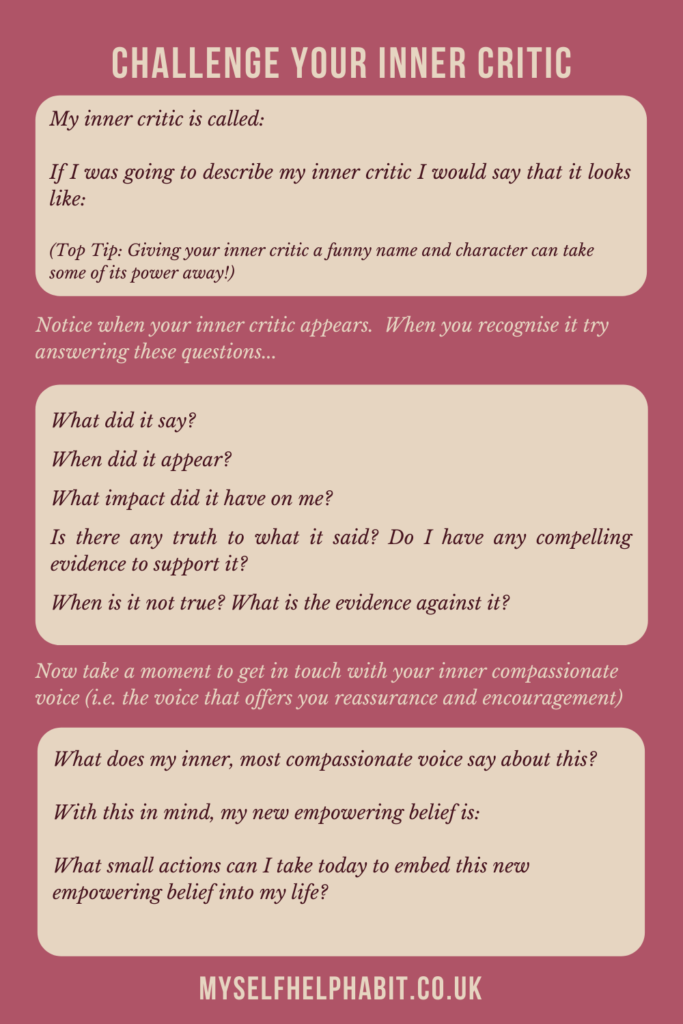
Coach Training Update (The Journey Continues!)
Since my last post, which outlined my steps to becoming a coach, I have completed the second module of my coaching course (yay!) and thought it was about time that I shared what I have been learning about coaching over the past month. I will also provide some more useful tips for new coaches that I have picked up during my training and give you some simple coaching tools that will help you to:
- Unearth the limiting beliefs that are holding you back and create new empowering beliefs that will move you forward
- Challenge your inner critic and tune into your inner compassionate voice instead.
What have I been learning?
My training programme covers many different topics and approaches related to coaching as well as allowing me to practise my coaching skills with clients. Here are some of the areas that I have found most interesting as I have gone through my second module:
The boundary between coaching and therapy
When first meeting the client, or even beforehand, a coach should ensure that the client understands what coaching is and what it is not. Coaching tends to be goal-orientated and focused on getting clients from their present situation to wherever it is they want to be by helping them to generate and talk through their options and address the internal and external barriers that stop them from achieving their goals. Therapy is generally focused on the process of healing the patient/client, who may have had difficult past experiences (possibly traumatic in nature), as well as diagnosing and treating specific mental health conditions.
However, this boundary is not always clear cut. There may be times in a coaching session when the coach will need to explore the client’s past experiences in order to understand the client’s current thinking, internal barriers, and resistance to change. The nature of asking open and probing questions that go beyond the surface level of an issue can mean that discussions move into therapy territory (for example, where a client might recall a particularly traumatic event while they are answering questions or undertaking an exercise). Coaches need to be aware of when this is happening and sensitively bring the client back to the original aim of the coaching session.
One thing that is clear is that coaches should never operate beyond the scope of their expertise and training and need to ensure that coaching is the right option for their clients. If they do notice any signs of potential mental health issues during their sessions they should have a referral process ready to discuss with their clients.
Considering the fine line between therapy and coaching has made me realise how important it is to do further training in mental health and I plan to undertake a Mental Health First Aid qualification in the very near future.
Neuro Linguistic Programming
The Association for NLP (ANLP) define Neuro Linguistic Programming (NLP) as a:
collection of models, techniques and strategies for modelling excellence, in order to help us better understand how our thought processes and behaviour, including how the language we use, influences the way we think and the results we get.
ANLP, 2020, Definition of NLP
As implied in the above definition, it is an area that is rich in effective techniques that can be applied to coaching sessions. The techniques that I found to be particularly interesting included:
- Focusing on understanding the client’s ‘map of the world’ i.e. how the client’s experience of the world is filtered through the client’s beliefs, values, childhood experiences, cultural influences, etc.
- Observing how clients represent their experiences through the language and descriptions they use.
- Learning how to explore relationships through the Perceptual Positions exercise which enables the client to consider a relationship from both his/her own and the other person’s perspective and then from an observer’s perspective. This can lead to new insights about the relationship that the client may not have considered before.
- Using timelines to pinpoint and explore significant moments in a client’s career history and then taking the learning from those experiences and applying them to present or future situations.
- Challenging cognitive distortions using the ‘chunking down’ technique which highlights any generalisations or deletions a client is making about his/her issue since ‘chunking down’ style questions encourage the client to get really specific about the issue he/she describing, thereby eliciting more details, and completing any parts of the story that have been missed out. For example, if the client tells you that ‘Everyone is against me’, you can ask ‘Who specifically do you feel is against you?’
I got so much from our sessions on NLP that I am looking into undertaking an NLP Practitioner course later next year (I’ve added this to my growing ‘wish list’ of specialist qualifications!)
Systemic Coaching
I have only just scratched the surface of this topic, but I like what I have experienced so far!
We had an introductory session where it was explained that the client is part of many different ‘systems’ (such as their family, organisation, team, etc.) and so coaching should not just focus solely on the individual. We then practised a very creative exercise where we got to play around with Playdoh and Lego (I mean what is not to love there!) Each piece of Lego or Playdoh represented a group or other entity that the client had some kind of relationship with. Clients had to think of an issue that they wanted to discuss and place a piece of Lego or Playdoh that represented themselves on the table in front of them and then make a decision as to where to put each group/entity (in relation to where the client had placed themselves on the table). As clients do this they explain what the piece represents to them, why it is significant to the issue that they are considering and why they have placed it in the position they have, which proved to be hugely insightful!
My main takeaway was that when exploring an issue with a client it is important to look at the context in which the issue sits and explore the different relationships that the client is involved in (considering who or what may be impacted by any actions or decisions that are made by the client). I have also purchased John Whittington’s book entitled Systemic Coaching and Constellations: The Principles, Practices and Application for Individuals, Teams and Groups so that I can do some further reading on this as I would like to be able to incorporate it into my practice one day.
The value of coaching supervision
It is good practice for coaches to attend regular supervision sessions (be it in a group or 1-1 setting) with a more experienced coach who has had training in coach supervision. This provides coaches with an opportunity to develop their coaching skills further, to check that they have taken the appropriate course of action and are upholding professional standards, and offers a supportive space in which coaches can disclose any issues that they are having with their coaching relationships.
My group subsequently set up some peer supervision sessions where we coached each other on issues that we were experiencing in our coaching sessions (while of course maintaining confidentiality.) I found it both useful and reassuring to be able to talk things through with other coaches and to offer support and guidance to each other.
Helpful tips for new coaches
I am learning so much as I practise and hone my coaching skills so here are a few key pointers that I think are worth keeping in mind as you develop as a coach:
Get familiar with your new coaching tools
When you are training to be a coach you will learn how to use a variety of coaching tools so that you can help your clients to explore their issues in creative ways. As I have been trying out these new tools in my training sessions, and particularly because I am using them online over Zoom, I can see the benefit of ‘rehearsing’ the tools a few times before using them with clients. I would recommend finding a willing volunteer and practising some of the coaching tools that you intend to use. Monitor and estimate the time that it takes to complete the tool fully, familiarise yourself with the different stages of the exercise, and make a note of any general questions that you may need to ask.
Additionally, you need to consider how a tool will work in practise with the technology that you have (e.g. over a Zoom call). Can you both screen share if you need to? Is the client able to move around the room that he/she is in or move the video camera to show you any work that he/she has created? You may need to provide some instructions to the client beforehand if you know in advance what tool/s you are likely to be using in the session or be ready to guide the client through it.
Pick up and unpack the client’s metaphors
You may find that, as the coaching conversation is flowing, a client will use metaphors to describe his/her experiences. These metaphors can provide clues as to how the client may be feeling about his/her issue and you can get a sense of what the experience of the issue is really like for the client. Using the client’s description of the metaphor, you can explore it in detail to get more insight into how the client perceives their situation and also to help the client come to an awareness of what they need to do to move forward.
When I have been a client in recent coaching sessions I have used metaphors such as ‘retreating into my shell’, ‘leaping across a crevasse’, and being on a ‘rollercoaster’ to describe some of my experiences. My coaches have promptly joined me in the world of my metaphor, where I have then been able to elaborate on what it is like to be inside and outside of ‘my shell’, outlined how I could build a bridge so that I could walk instead of leap across the crevasse, and articulated what the ‘ups’ on my rollercoaster were like thereby getting clearer on how I can manage the dips in the rollercoaster.
Take time to explore how the client is thinking about the problem
A client can come to a coaching session with a problem that he/she is grappling with and the coach can get beyond the surface of the problem by asking questions that explore how the client is thinking about, and approaching, the problem that he/she has brought to coaching. The coach therefore looks at what is going on internally for the client rather than focusing on all the external circumstances of the problem.
This can actually be far more helpful to the client than going in directly to tackle the ‘ins and outs’ of the problem itself since it can reveal the root cause of the problem, open up alternative options or perspectives the client may not have considered, and can enable the client to generate more effective solutions. For example, if a client is having trouble making a decision about something you could ask ‘What is making this decision so difficult for you?’ in order to reveal what is really getting in the way of the client making the decision before you launch into all the pros and cons of the options the client is considering.
Meet the client where they are
It is important to establish where the client currently is with the issue that he/she is bringing to coaching session so that, as well as gaining an understanding of the client’s current situation or state of mind, you can adapt your approach and questions accordingly and ensure that the session remains tailored to helping the client to move forward from his/her own personal starting point.
I reflected on the power of this in a recent coaching session, where I was having some trouble envisioning what my business could look like in five years’ time but was very curious about what the future may hold and wanted a ‘bigger picture’ to work towards. My coach started by asking me to describe where I currently was with my business planning, how far into future I had got with my thinking, and we established what I really wanted to achieve from the session. Gradually, with encouragement from my coach, I was able to start building up my vision from there, taking each year in turn, and it wasn’t then so overwhelming for me to think further ahead into the future.
Refrain from giving advice
In coaching we want our clients to come up with new ideas and discover their own answers to the problems that they are experiencing. However, as most coaches just want to be as helpful as possible the desire to rescue or fix things for the client by offering lots of advice and guidance can be incredibly tempting. However, our solutions may not actually be the best course of action for our clients since we cannot possibly know the full details of their situations as well as they do. They could also take our advice and then find that it does not resolve anything for them and this can jeopardise the coaching relationship.
I have found that the best way of avoiding the temptation to give advice is to hold this one important belief – that the client is ‘creative, resourceful and whole’ (which I saw in an article entitled What’s Inside Your Heart as a Coach? by Emma-Louise Elsey for the International Coach Federation). This means that we believe that clients are more than capable of resolving their issues and that coaching gives them the space, questions and tools to think things through, to formulate options, consider different perspectives and, finally, to come to their own conclusions.
You can then put your trust in the process of the coaching by following the client’s lead, staying attentive, curious and unattached to any particular outcome, and by simply exploring the situation together as the conversation flows.
It is ok to make mistakes!
I have realised that coaching is very much an evolving skill set that does not have to be completely polished up front. It is perfectly ok to experiment with your questions and tools, and even get things a bit wrong in a coaching session (acknowledging that some questions, tools or techniques may work well and others may not.) If you do make a mistake, just apologise if you need to, forgive yourself and move on with the session!
Reflecting on your practice, learning from mistakes, and engaging in ongoing personal and professional development is all part of being a coach.
Try out some coaching tools!
Unearth the limiting beliefs that are holding you back
The limiting beliefs that we hold about ourselves, and the world around us, can pose a huge barrier to achieving our goals because they convince us of what is and what is not possible for us, make us overly cautious, and restrict our progress.
Such beliefs may have been formed right back in our childhood, from the things that we witnessed influential figures (like our parents, teachers and peers) saying or doing and have since remained largely unquestioned. We adopt these limiting beliefs to keep ourselves ‘safe’ and to ensure that we are accepted by our loved ones and the society we live in.
So, what can we do about our limiting beliefs?
Sometimes they are tricky to spot and they can creep into our decisions without us even realising it. We might find ourselves stuck in a rut, wondering why we are not making any progress, or feeling fearful about taking that next step in our lives. If we start to investigate the thoughts that we are having about these situations we may be able to reveal the limiting beliefs that are holding us back. They usually start with phrases like ‘I can’t…’, ‘I am…’, or ‘I don’t have…’.
Here are some coaching tools that will help you to identify and question your limiting beliefs. You can then create some more empowering ways of thinking about the situation or issue that you are facing which can in turn help you find the courage to take your next steps.
Have a go at doing the exercises below on your own or partner up with a close friend/colleague and discuss the outcomes of the exercises and what they mean for you.
Create a mind map of your thoughts
An effective exercise that helped me to unearth all the things that I was telling myself about a situation that I had been mulling over, involved simply mind mapping the thoughts that I was having around it.
In the centre of a piece of paper summarise the situation or issue that you are considering (e.g. condense it into a title) and then, going around the outside of the title, spend 10 minutes or so writing out whatever thoughts come into your mind when you think about that situation or issue.
You may come up with both limiting and empowering thoughts – just get them out of you head and on to the paper!
Here is an example:

The next step is very important as you may find it a little depressing if there are a lot of limiting beliefs coming out and you see them all reflected back at you on paper! So, once you have noted everything down, acknowledge any positive or empowering thoughts you have already had on the situation or issue (you can lean into these thoughts to spur you on!) Then, take another look at the limiting beliefs and ask yourself:
- How does this belief serve me? What positive intention might it have?
- How does the belief not serve me?
- Is it actually true?
- Is this belief even mine? Do I need to metaphorically hand this back to whoever gave it to me and then rewrite what is true for me now?
- What would be a more compassionate way of thinking about this?
Now see if you can reframe the belief. You can still be realistic but just see if you can turn it into a more empowering statement or even a question that opens up possibilities for you, for example:

Take action to reinforce your new empowering beliefs!
Once you have your empowering beliefs, think of regular, small actions that you can take to gradually build up evidence that these new beliefs are true and find ways to give yourself a pat on the back when you carry out these actions.
Capture your inner critic
As you go about your day you may notice that an inner critical voice pops up every now and again, seemingly trying to sabotage whatever it is that you are trying to get done or stopping you in your tracks completely with its harsh words and berating tone!
The worksheet below shows you how to disempower your inner critic, to capture and question it when it appears, and to get in touch with your most compassionate inner voice (that can offer you a more empowering belief to take forward).
I am just about to begin my final module and will share another update soon after I have completed my training!
This post contains no sponsored material or affiliate links and is based on my own opinions, views and experiences of carrying out the activities described above.





